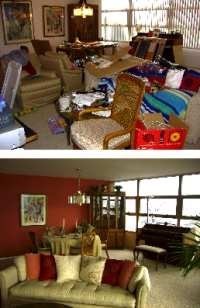
No matter what real estate market we find ourselves in, we all know that it's never easy to sell a home. In the last several years, a new trend has emerged in the real estate arena that is said to help homeowners sell their houses or apartments faster and for more money. This practice - known as "home staging" - is widely recommended by real estate agents all over the nation.
The idea behind home staging is essentially this: living in your home and trying to sell it are two different things. Staging is the practice of making sure every physical aspect of your home is ready to show to potential buyers - and hopefully get them thinking about making your home their own. This could include de-cluttering, editing and rearranging furniture, painting and doing repairs, removing personal items, cleaning and a myriad of other possible tasks.
Creation of an Industry
The home staging industry first emerged in 1972 when realtor Barb Schwarz began helping California clients market their homes. After her realization that a nicely staged home sold faster and for more money, she formalized her method and began teaching classes on the topic. In 1985, she began touring the country, sharing her ideas with realtors at conventions.
Soon after, she realized that realtors don't always have the time both to carry out their duties as realtors and to perform the tasks required in staging a home for sale. So she began training others to do it in 2000. Today, more than 10,000 students have earned the designation of Accredited Staging Professional (ASP) through her program - and since then, many others have begun training organizations of their own.
"The way you live in your home and the way [home stagers] market and sell your house - your product - are two different things," Schwarz says. "Staging is not decorating. Decorating is personalizing - staging is de-personalizing. When it's time to market your home, you must neutralize it for a wider group of buyers," she adds.
Spend a Little, Save a Lot
Across the board, home staging professionals will tell you that the costs of staging your home are insignificant compared to the rewards you will receive in the forms of a higher selling price and a quicker sale. "Longevity on the market means one thing: reduction in price," says Schwarz.
"The more you put into home staging, the more you will get back, there's no question," attests Conni D'Emidio, an Accredited Staging Professional and owner of Take Center Stage, a home staging and interior decorating business in Bayside. "You don't simply get a higher selling price, you also sell faster. You don't have to sit on your mortgage for months and months."
Basically, the staging process involves having a professional home stager come in to your home for a consultation. They'll tell you what needs to be done to prepare your home for sale. In the New York City market, the fee for the initial consultation generally runs between $300 and $500, according to Nairn Friemann, a professional home staging consultant in the city and owner of Ingenuity & Pizzazz, Inc., a staging company that offers one-day apartment transformations.
After the consultation, pricing varies. According to Schwartz, who has offices in Chicago, San Francisco, and Seattle, the average fee to stage on the East Coast is $3,800. In the Midwest, it's $1,800, while on the West Coast it's around $2,800. This cost typically includes everything the stager does, including labor, purchased items and possibly rented furniture.
The general rule is to spend one to three percent of your asking price on staging, according to Friemann.
"Cost is a word associated with 'waste' and 'risk,'" says Christine Rae, President of Canadian Staging Professionals (CSP), which offers intensive training programs throughout North America. "The investment of hiring a professional more than outweighs any price."
"I talk with a lot of real estate agents, and there is skepticism out there," Rae adds. "They ask, 'Why now? We used to sell homes without home staging,' to which I reply, 'Yes - and we used to read books by candlelight.'"
"I would say you can't afford not to stage," agrees Maggie Denny, an accredited staging professional who works in the New Jersey and New York areas. "It's such a small investment, and the return is just phenomenal.
Making Magic
"[Professional home stagers] understand how to stage across all geographic areas and price points," says Rae, but some stagers specialize in certain areas, like co-ops and condos.
Most will consider the same factors when they come in to do their consultation, however. They'll look at whether a room needs to be de-cluttered (most do), whether some pieces of furniture need to be edited out or rearranged, how the use of color impacts the space, and whether any repairs or upgrades need to be made to the property.
"Clutter eats equity," advises Schwarz. "The key is less is more. So pack it up, de-accessorize. Put away the knick-knacks and the hat collection and the golf ball collection. Potential buyers will think, 'This place is crowded, I can't imagine living here!'"
In making a space appeal to the masses, D'Emidio says another trick home stagers use is to get rid of all personal items, like family photographs, as well as "emotional lightening rods." "These include anything having to do with religion, politics, sex or weapons," she says. "The less you have in a house that could turn somebody off or offend someone, the better."
For instance, crazy as it may sound, a potential buyer could walk into the foyer, see a crucifix hanging on the wall, and subconsciously think, "I'm not Catholic, I can't live here."
"We tend to take out furniture to have a lean, cleaner look," says Friemann. "Very key in the New York City market are Internet photographs of properties. Buyers today first shop on the Internet, and if they don't like the photographs on the various brokers' websites, they won't even go to look at the apartment. So as a home stager, I take a very different perspective on how a home is laid out. I look at it from the camera's eye."
Friemann and other home stagers in the city often work in very small spaces, so getting rid of furniture is crucial to making a space look as spacious as possible.
Other Factors
Color is also very important to home buyers, even if they don't realize it. Up to 50 percent of the first impression is based on color, according to Friemann.
As far as color goes, "white just doesn't work," says D'Emidio. "Everybody thinks they have to pick white, but that's just not right. I try to help choose colors for them that are not strong colors, but rather colors that are 'in' and appealing to the people who are buying now," she adds.
"Our specialty is really showcasing rooms," reports Friemann. "And that's an art, not a science. This is where our talent really comes into play, when we come in and do room rearrangements and bring in accessories and plants and that sort of thing."
"We use a lot of smoke and mirrors," laughs D'Emidio. "I've taken a cardboard box and put an air mattress over it and made an unbelievably gorgeous bed - but don't sit on it! I mean, don't really use it. It'll come down! We use a lot of tricks like that because we don't want to schlep stuff around and we want to keep the home-sellers' costs down."
Repairs or upgrades to your apartment or home might also be necessary before it's ready to sell. For instance, you may need new bathroom or kitchen fixtures, new carpeting, refinished floors, new window coverings, updated appliances, or even plumbing or electrical upgrades. These things will drive up the cost of the job, of course, but could very well be the difference between selling and…waiting to sell.
Be cautious about costs quoted on the "design-on-a-dime" television programs that have become so popular, however.
"TV shows have been excellent in terms of increasing awareness of staging," says Friemann, "but they're not so great on the costs involved. They don't factor in that they've had a team working full-time for a week. And in New York City, trades people are relatively expensive, compared to some of the people featured in these programs. There are regional differences to consider."
Vacant Properties
Another challenge in trying to sell comes when the home is vacant. Empty apartments have the potential to sit on the market for months on end.
"A lot of people think that a home should be empty - but that's not necessarily true," advises D'Emidio. "A house should always have some furniture in it that shows off the room to its best advantage. When something is in the room, all of a sudden people can get their minds around the space a little easier. Also, a room looks bigger when something is in there."
"Go back to how we're buying in New York City - off the Internet," Friemann says. "Without furniture, the average buyer cannot visualize what a room could look like. Someone looks at a big square box, and they have no idea, no perception, and there's nothing that evokes any emotion."
"When we stage vacant properties, we don't bring in every piece of furniture, but it's really important to re-create the function of the room, and that gives people certainly an idea of the size of the room, and the lay-out," she adds.
No Guarantees
Even though home staging has been found to increase the chances of both a higher selling price and a faster sale, there are no guarantees. If your home is in an undesirable area, for instance, then it will sell only as fast as the market will allow. But staging will help it go as fast as possible.
"The property needs to be priced appropriately," suggests Denny. "But there is a buyer for every property out there. Everybody has different needs. But home staging is definitely a concept that is worth exploring and investing in."
"You must look at what your return is," says Schwarz. "Not just what you're putting into it. We're not going to ask you to spend money. We're going to ask you to make an investment in time and energy. The main key here is that the investment of staging your home is less than a price reduction on your home."
Domini Hedderman is a freelance writer and a frequent contributor to The Cooperator.






Comments
Leave a Comment